#taira no shigemori
Text
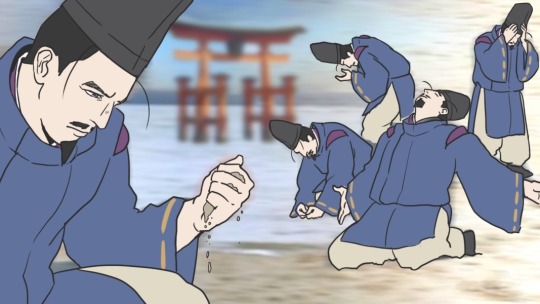
tfw you can’t be a filial son and loyal to the emperor at the same time
97 notes
·
View notes
Photo

A large sacred camphor tree said to have been personally planted by the military commander and top court official Taira no Shigemori (平重盛) in 1127 on the grounds of Kumano Nachi Taisha Shrine (熊野那智大社) in Nachi Katsuura, Wakayama Prefecture
Image from “Nachi ni Modete” (那智に詣でて), undated booklet available at the shrine in the mid-1990′s, page 7
#和歌山県#wakayama prefecture#那智勝浦町#nachikatsuura#熊野那智大社#kumano nachi taisha#japanese history#平重盛#taira no shigemori#crazyfoxarchives
66 notes
·
View notes
Photo
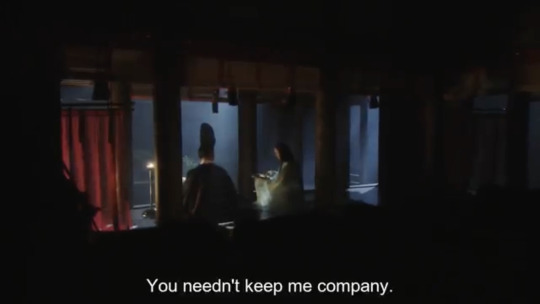




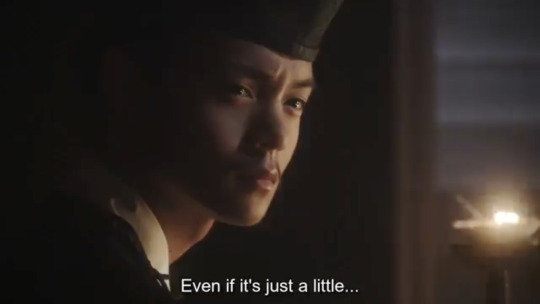



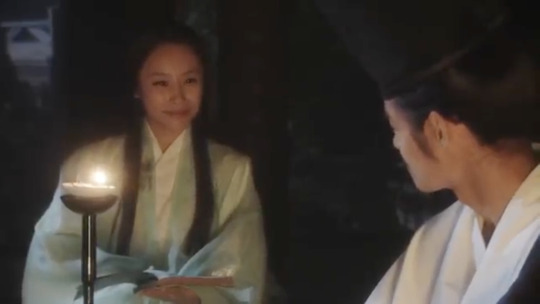
Taira no Kiyomori (Ep 38)
Tsuneko (Takahashi Ai) is curious by what her husband, Shigemori (
Kubota Masataka) has been reading late into the night in order to prepare himself to take over the Heike Clan should his father, Kiyomori dies.
Instead of telling her she need not have to worry about the Clan matters, he encourage her to join him in reading that he shifts his lamp closer to her for her to see what she is reading so that she may help him in ruling one day.
#taira no kiyomori#taira no shigemori#kubota masataka#fujiwara no keishi#takahashi ai#taiga drama#japanese drama#j drama#jdrama#dorama#japan#historical drama
11 notes
·
View notes
Text
Best Underrated Anime Group D Round 1: #D2 vs #D7
#D2: Prophecy girlie, hyper cellphone, and gamer cat get silly
Su Moting, the daughter of a god and a monster, is the supposed Chosen One set to fix the balance of the universe, but unfortunately, she’s just barely living as it is. Only just told of her great fate, Su Moting couldn’t care less as she juggles her social life, work, and her new duties (which she doesn’t take seriously). Alongside Moting are Star Tianji and Star Dikui, a god and a monster out to help our protagonist with her grand mission. They, too, are also struggling to figure out life on Earth, as Tianji is an immortal who doubles as the god of Su Moting’s personal cellphone and Dikui is a cat monster immortal more concerned with lazing about. Somehow, they make things work as the best worst roommates of all time.

#D7: Girl who can play the biwa and see the future. 1180 CE Japan
The main character can play the biwa and also see the future with one of her eyes. After her father is killed at the start by the Taira clan, she is taken in by Shigemori of the Taira clan, who has the ability to see the ghosts of the dead. He wishes for her to help prevent the downfall of the Taira clan, which she has witnessed, but she refuses to since they are the ones that killed her father. Instead, she chronicles the events of their rise and fall, playing the biwa.
Titles, propagandas, trailers, and poll under the cut!

#D2: God Troubles Me (Hanhua Riji)
youtube
[Admin: Submitter had linked the ending song, but it doesn’t really show us what the animation is like, so I went to find an actual trailer. Above is a teaser for season 3, but there are no spoilers.]
Alt Title: Man’s Diary
Propaganda:
Four-season donghua (Chinese anime) that’s so recent and seeped in American pop-culture that I needed to do a double take when a literal cockroach said “Run, Forrest, run,” in English with a heavy Chinese accent. There’s a cat who plays video games (he’s very good at it), a phone who’s the worst kind of hype man, a sentient air conditioner, a guy who can shapeshift into any vehicle, off-brand Super-Man but jerky, a high-ranking god that collects anime figures, and the mega ultra cool protagonist who is a normal human girl fresh out of college and always low on money. It’s great
Trigger Warnings: Animal Cruelty or Death, Child Abuse, Emotional Abuse, Flashing Lights, Racism, Self-Harm, Suicide.
All the TW’s above are done for comedic effect, but they come in fast and hard with the humor. Better safe than sorry! The biggest things I remember are one or two “blink and you’ll miss it” racist jokes, characters joking about killing themselves out of embarrassment (no one goes through with it), and there’s a LOT of self-harm via stupid decisions. Stupid things like tying a loose tooth to the back end of a sports car sort of stupid. The protagonists have 3 brain cells collectively.

#D7: The Heike Story (Heike Monogatari)
youtube
Propaganda:
It’s based on historical events, so one can already know the ending before watching it, sort of like the main character Biwa. But seeing those events, getting attached to the characters as they have both fun, simple moments and difficult, painful moments and seeing the humanity in the characters and watching them grow up with the underlying promise that things won’t go well for them, and accepting that… themes of impermanence and grief… but also the art style is unique and bright and the music is great and fits the scenes, and I highly recommend watching this if you haven’t already !! It’s only 11 episodes!
Trigger Warnings: Suicide

If you’re reblogging and adding your own propaganda, please tag me @best-underrated-anime so that I’ll be sure to see it.
#anime#donghua#best underrated anime#polls#poll tournament#tournament#anime tournament#animation#animated show#group stage#group stage round 1#tournament polls#chinese anime#god troubles me#hanhua riji#the heike story#heike monogatari#han hua ri ji#group d
39 notes
·
View notes
Text
A Spring Night's Dream
Summary: Kiku watches as Taira Clan crashes and burns
The morning that Japan met Tadamori, the first Taira to enter the imperial court, he was awoken by bells.
Tadamori was chaotic and ambitious and was the first samurai to serve the Emperor. Tadamori helps deal with pirates, but there is not much more Japan can say about him.
Tadamori dies, and his son Kiyomori is much more successful than his father. He helps the Emperor put down rebellions, and soon, the Taira family is everywhere; they occupy almost every government position.
Kiyomori is even more prideful and arrogant than his father, parading around like he owns the place, and Japan comes to hate him. Just not enough to kill him.
However, some people hate him that much, even the former Emperor. They start a plot to overthrow him, but Kiku truthfully doesn't care enough to stop them.
Then, a fire turns the palace into cinders, and suddenly, Kiku has more significant problems.
Taira No Kiyomori eventually finds out about the plot, and he has the monk executed and the rest of them exiled to some island. Kiku hears that a piece of a stupa they made reached the shore; Kiku feels terrible for them.
Kiku doesn't feel bad for them for long. Kiyomori's daughter falls sick while pregnant, and everybody blames it on the angry spirits of the people he executed and exiled. Kiyomori's son is allowed to come home, but Kiku is pretty sure one of them was left on the island.
The imperial prince is born and is as annoying as all babies can be. A whirlwind strikes the capital, which only serves as an omen for future bad things.
Shigemori, the only Taira that Kiku could bear to hang around with, dies of an illness; on his deathbed, he confesses to Kiku that he asked the gods for a quick death if the Taira Clan is to fall.
Without Shigemori's restraining influence, Kiyomori is on the brink of war, and Kiku prepares for more pain.
But in good news, Kiyomori's daughter gives birth to a son!
The Emperor is forced to retire, and a 2-year-old claims the throne. Indeed, the toddler holds no real power, and it's all his grandfather. Still, Kiku relaxes by entertaining him without thinking too hard about what will eventually come of him.
Kiku's assumption about trouble to come is sadly correct because retired Emperor Go-Shirakawa's second son, Prince Mochihito, is convinced by an old friend of Kiku's named Minamoto No Yorimasa to claim the Emperor.
The whole thing worsens because Kiyomori's son, Taira no Munemori, steals Minamoto No Yorimasa's horse.
And suddenly, Kiku is preparing for a battle against many sohei. They fight bravely but are swiftly and quickly defeated by the Taira forces. Minamoto No Yorimasas commits seppuku inside the temple while his two sons fight outside. They capture and kill Prince Mochihito shortly after the battle is over.
Kiku is relieved that this ordeal seems to be over. Still, when he hears that one of Prince Mochihito's sons has fled north to join up with more anti-Taira forces, he considers committing seppuku himself. Also, Kiyomori burns down so many temples he might as well have been praying for defeat.
Kiyomori moves the capital to Fukuhara-kyo, and then he laments about strange visions he sees of skulls and ghosts, and Kiku knows he is doomed.
A person that Kiku thought he would never see again comes up, and a monk named Mongaku convinces Minamoto No Yori to also rebel against the Taira. And honestly, Kiku needed to find out where Kiyomori got all those enemies.
Kiku only stays at Fukuhara-kyo briefly, and soon they're moving back to Kyoto. Then, monks at Kofuku-ji kill messengers that Kiyomori sent, fearing an attack. Then Kiku discovers why Kiyomori has so many enemies.
He lays siege to Nara, destroying every temple, scripture, and statue. Only one survives. Memories that Kiku held dear.
Now, Kiku watches the Taira clan fall with glee.
Kiso no Yoshinaka (cousin of Minamoto No Yoritmoto) has also started a rebellion, which causes Kiku more happiness despite his growing migraines.
Another good thing that happens is that Kiyomori falls ill. His fever is so high that even water sprayed on him turns to black dust and ash, but a famine follows his death, leaving Kiku starving no matter how much he ate.
Despite all of this happening, the Taira are still winning. At the siege of Hiuchi, despite Minamoto heavily defending the fort, a traitor inside the fort sent a message about how to get over the defenses.
And while Kiku could quickly sabotage their workings, he still had no desire to see any of his people get killed, regardless of what they were doing was wrong.
The tides of the war would change later that year with the Battle of Kurikara. First, the Taira general assumed that the Minamoto had a more enormous army than they actually had, and then he started a formal battle.
First, the archery exchanges using whistling-bulb arrows and individual duels amongst 100 samurai.
But as the sun set, the Taira had found themselves surrounded by another Minamoto detachment, holding many more flags than they should've, convincing the Taira even more that they were facing off against a dangerous threat.
Then they released a herd of oxen down the pass with lit torches tied to their horns. Many of the Taira soldiers, including himself, were knocked off the path, meaning that the Minamoto captured him. Something he didn't end up minding all too much.
Kiku was executed for the show, but after he came back once again, he was given his duties.
A string of victories followed for the Minamoto, and the war would end with a naval battle. But this upcoming maritime battle would be difficult. The Taira were skilled in their sailing and naval tactics. But the Minamoto had more ships and allies.
The Taira had their fleet divided into three squadrons, while the Minamoto fleet was all together. The tide changed when the ships came close for people to board the other's ships. Then Taguchi Shigeyoshi did indeed defect to the Minamoto side and told them which ship the Emperor, along with the imperial regalia.
Once Taguchi told them that, Kiku knew what they were about to do.
He jumped from ship to ship; Taira soldiers committed suicide by jumping into the ocean. Kiku reached the Emperor's craft, where most rowmans had already been shot dead.
Kiku ran around the boat. He found the mirror in the hand of a dead attendant, but the other two were nowhere to be found. Kiku made his way to the front of the boat, where an attendant stood.
"They jumped into the water!" She yelled. Kiku's eyes widened, "who?" The attendant gestured to the water. "Kiyomori's widow and the Emperor. They tossed the Imperial Regalia into the ocean!"
Kiku jumped into the water after them; he swam down, hoping to find either the sword or the jewel. Kiku blindly grabbed through the water until he grabbed onto something. Kiku resurfaced as the attendant helped him out of the water once again.
Kiku finally got to see what he had grabbed onto. He chuckled; it was the imperial jewel. The attendant smiled, "Good job, sir."
The Taira clan was defeated, and the Emperor became nothing but a figurehead, with the shogun holding all the power. It seemed Kiku couldn't get a moment of peace. The sword was lost forever, but a replica was soon found.
This war changed Kiku's life; for better or worse, Kiku can not tell. He also learned of karma and that every wrong action will always come back for you. Too bad Kiku didn't retain that lesson.
5 notes
·
View notes
Text
Mini-Review: The Heike Story
A young orphan named Biwa is taken in by the powerful Taira Clan—also known as the Heike—after their leader witnesses her extraordinary psychic abilities. Unfortunately, what she predicts is a future of bloodshed, violence, and civil war. Inspired by the 12th-century epic tale Heike Monogatari.
Something different from the normal genres I watch, this is an adaptation of a nearly millennia-old epic. I think that’s pretty clear going in, and I have at least heard of The Tale of the Heike, though my knowledge stopped at “Heian period story involving military,” which isn’t wrong, but clearly barely scratches the surface.
The main character is Biwa, named after the stringed instrument she plays. With her father, they wander the country, performing to earn their living. But Biwa also has a secret: one of her heterochromatic eyes sometimes sees the future. When her life intersects with that of a Heike nobleman who takes her in, she gets a front-row seat to the approaching civil war he hopes to avert.
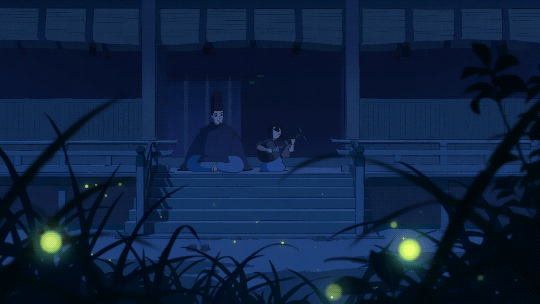
Knowing some history or context undoubtedly helps. For example, Biwa is a biwa (similar to a lute) player, and often narrates the story over her instrument. Looking some things up online after I watched, I read that the story was traditionally told, and passed down (even to the Japanese monks who first wrote it down a couple hundred years after the war), by traveling biwa players. So Biwa-the-character’s presence, more than just an observer and narrator, ties in to its history in Japan.

That said, you don’t have to know Japanese history for this! Like many historical stories, that probably helps, but things like power struggles, politics, and war are easily understood (and reliably entertaining in fictional form) regardless.
Court and political intrigue, battle, ghosts--it feels like an epic. And while it gets serious, those parts hit so much harder because of the first episodes, which both get us established, and show us that the main nobles we’ll see--Shigemori, the kind-hearted noble who takes Biwa in, and his four children--are really likable.
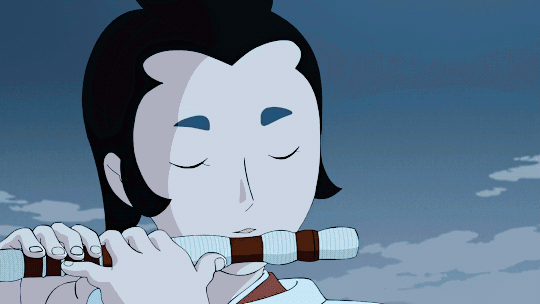
That makes it hit harder when Biwa sees what’s coming, but can’t stop it. This helplessness in the face of future tragedy really makes it feel like a classical story. There are bad decisions, there is hubris, and there are so, so many people who pay for it.

One criticism I have is that it’s really hard to tell the passage of time, unless the characters state it outright. Biwa herself hardly changes throughout (and at least one character remarks on this), and adults don’t change much, so it’s really only through characters we meet as children that we understand that several years pass during this series. I really think they could’ve done a better job of conveying the passing of time.
Also a bit confusing were the many similar names, which isn’t helped by the occasional character designs that were also similar (Emperor Go-Shirakawa and Taira no Kiyomori, head of the Taira/Heike clan, were both bald old men who I frequently mixed up). All the names, except for Biwa, come from the original Heike Monogatari, so can’t be helped, but when yet another finely-dressed noble shows up on screen, it was hard to visually differentiate some, and the names were often similar (Shigemori, Kiyomori, Koremori, Munemori, Sukemori, Atsumori)
There’s a melancholy tone as the Heike continue or are drawn towards conflict, and all Biwa can do is watch, bearing witness to a civil war that she eventually shares as a musical tale. The melancholy tone is aided by the biwa music, strings echoing without accompaniment.

Framing of the camera and similar decisions also added to the story. Just like how the characters, in such polite high society would allude to things and talk around a point rather than bluntly stating something outright, the camera often focuses on a character’s back, or hands, or lower part of their face, letting the viewer making the connection with what’s happening, or what the character is feeling, without showing it outright.

Verdict
English dub? Yes
Visuals: Very nice! The art style, with its flat colors, minimal shading, and not overly-stylized character designs, might bring to mind woodblock prints.
Worth watching? Yes, although it’s not something I binged due to its more serious, and heavy, nature. I usually watch lighter or more humorous shows, so it was a change to go into something that tells you up front “hey, this is the story of a war and a clan’s downfall.”
Where to watch (USA, as of February 2023): Funimation, Crunchyroll
Click my “reviews” tag below or search “mini review” on my blog to find more!
5 notes
·
View notes
Text
Sukiyaki Western Django by Takashi Miike
In 2007, director Takashi Miike released the film Sukiyaki Western Django. This movie combined the essence of Japanese culture with the Western genre, following the trend of Spaghetti Westerns that became a global sensation after Akira Kurosawa's Yojimbo was adapted into a Western as A Fistful of Dollars. Despite most characters being Japanese, they all speak English, with Japanese dialogue appearing only twice. The film features a remarkably lavish cast, though some seemed to struggle with their acting, perhaps due to the challenge of performing in English. While the movie might aim for a Western atmosphere and international appeal by using English, I couldn't help but think that having the actors perform in Japanese with English or other language subtitles might have been a better choice. In short, it felt like an extravagant farce with a luxurious cast, complete with comedic moments and even a chabudai flipping scene. However, the top-notch cast performed the funny scenes with sincerity, and combined with the power of the action scenes and the elaborate costumes and sets, it was still enjoyable. But, I wonder if people unfamiliar with these actors would still find it entertaining.
One of the most memorable aspects was undoubtedly Minamoto no Yoshitsune, who, wielding a Japanese sword and handling guns stylishly, exuded charisma in every scene. As a fan of him as the actual historical figure, I was satisfied with Yoshitsune's portrayal, though the rape scene was not good though. In contrast, the leader of the Taira clan, Taira no Kiyomori, who adopts the name Henry, uses his subordinates as shields and behaves chaotically. Shigemori, who faithfully accompanies him and affectionately calls him Henry, is adorable. Also, Bloody Benten who is Akira's mother and Heihachi’s grandmother and has a large tattoo of Benten on her body is incredibly strong and beautiful. The scenes depicting the sorrow of Heihachi's mother, Shizuka, through dance and her enchanting performances were also excellent. All of the characters including the insane Yoichi and the sheriff, were very well-defined, and the actors truly embodied them, which was impressive. Perhaps because of this, the protagonist, the gunman, while cool, seemed slightly overshadowed. Quentin Tarantino's portrayal as the excessively meticulous uncle of seasoning and ingredients for sukiyaki was quite amusing. He came across as an anime enthusiast, hence the name Akira for his son, which was a nice touch. Akira seemed like a decent guy, and I wished we could've seen more of him. However, it was surprising to see someone like Shun Oguri used for such a fleeting role, and famous supporting actors appearing in minor roles like collapsing with bullet holes in his stomach. The use of the space created by the bullet hole was an amusing directorial choice. Nonetheless, it seemed like everyone had an extraordinary vitality; even when they suffered fatal injuries, they didn't immediately fall or die, which added a humorous element to several scenes.
The backgrounds that appear in the early and middle parts of the film give off a distinctively set-like vibe, over-the-top sound effects, anime-style inserts, and manga-like editing were also striking. While the storyline itself was somewhat typical, with no major twists, the outstanding performances and intense action made it immensely enjoyable. The juxtaposition of the red symbolizing the Taira clan, stained with blood, and the white snow symbolizing the Minamoto clan, along with the red and white flowers representing love blooming amidst it, was beautiful. The scene where a baby, Heihachi, emerges from these flowers is particularly memorable. Also, the confession scene where Toshio confesses his love for Ruriko, not as Bloody Benten but herself, and the scene where the sheriff falls with the crucifix were also impactful. If possible, I'd love to watch it again with Japanese subtitles.
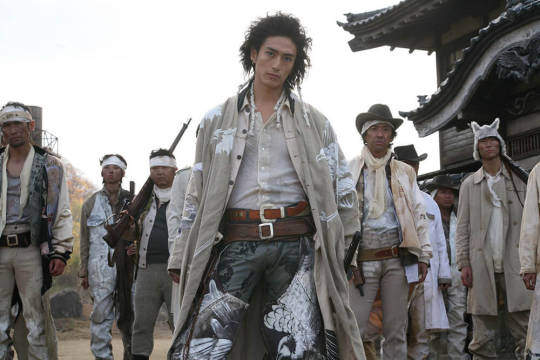
1 note
·
View note
Photo
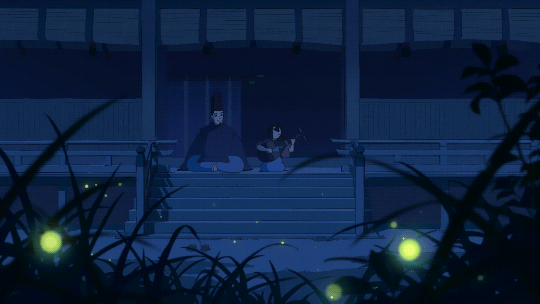
145 notes
·
View notes
Text

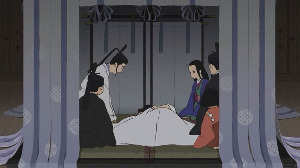
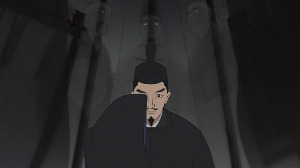
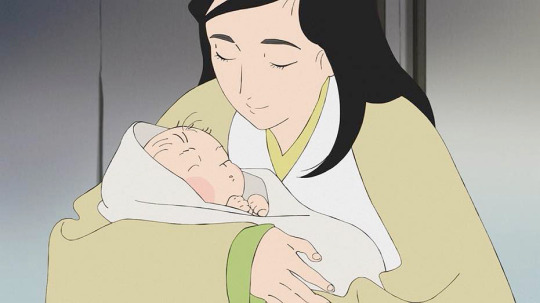



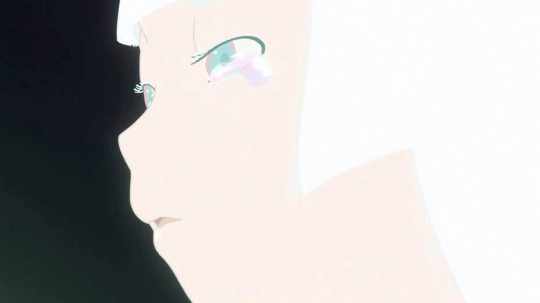
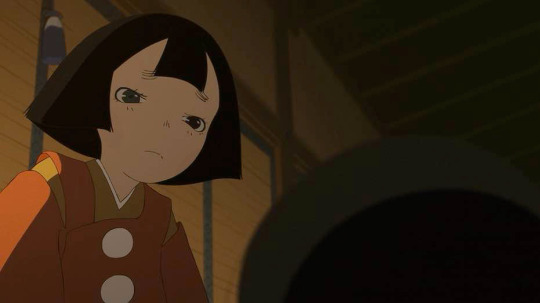

Heike Monogatari is really good, I haven’t read the source material, so I’ll be treating this only as an anime. Though it can’t get a bit hard to follow Biwa is an amazing character, and all the tragedies alongside that beautiful animation and music makes this anime a nice experience.
Rest In Peace Shigemori. Now Biwa has his eye and she showed us how frustrated she feels; how are things going to be from now on? will Biwa be able to change the tragic future of Tokoku and her child? I don’t think the Taira clan will survive.
#heike monogatari#biwa#taira no Shigemori#taira no kiyomori#taira no tokoku#historical anime#anime#animation#animes#anime moments#anime blog#anime recap#anime girl#anime review#drama anime#fall anime 2021#first impressions
26 notes
·
View notes
Photo
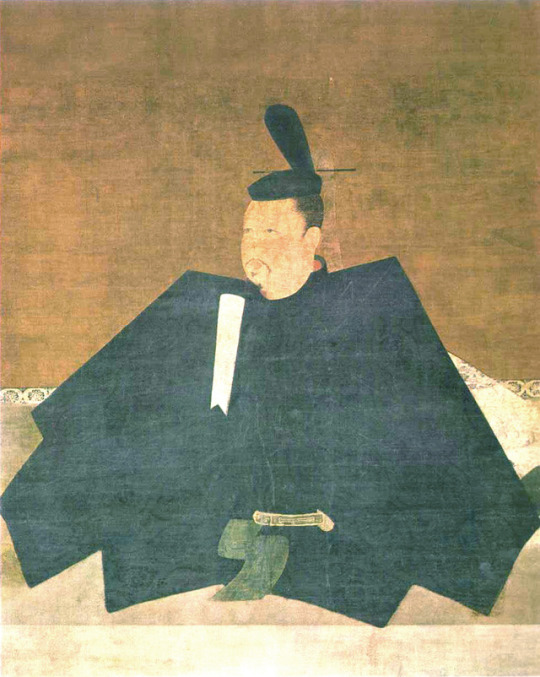
Fujiwara no Takanobu (atribuido): Retrato de Taira no Shigemori, o bien, retrato de Ashikaga Takauji (color sobre seda).
1 note
·
View note
Photo

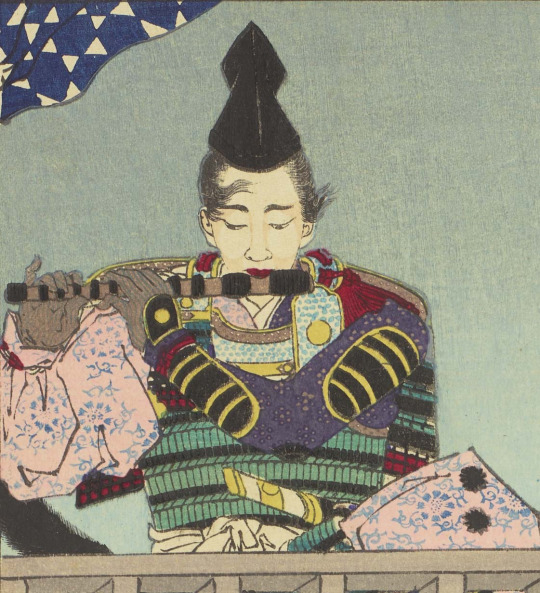
Taira no Kiyotsune, the grandson of Taira no Kiyomori and the son of Taira no Shigemori. After being chased from the capital and blowing a flute, which he is good at in Yanagiura, Buzen Province, he committed suicide by drowning. 21 years old. Yoshitoshi Tsukioka depicts the figure of his determination to commit suicide in "One Hundred Aspects of the Moon". Text by Ota Memorial Museum of Art.
292 notes
·
View notes
Text





Small artdump from my twitter for my beloved heian blorbo
35 notes
·
View notes
Text
Anime of the day: Heike Monogatari
Alt title: The Heike Story

Released: 2021
Biwa is special. She possesses an eye that allows her to see the future. However, while young, Biwa makes a crucial error that costs her the life of her father: she disrespects the Taira clan. The Taira hold a great amount of power in Japan and they aren’t afraid to demonstrate or protect that power.
But fate isn’t done tying Biwa to the Taira. Later she meets the eldest son of the clan leader, Shigemori. Shigemori takes Biwa in as a way to repent for his clan’s misgivings. He and Biwa are quite similar, after all, he also possesses a gift: he sees dead people. However, life isn’t so easy living in this extravagant environment especially since the Taira clan is destined to fall. Biwa has seen it.
#Heike Monogatari#The Heike Story#2021#anime recommendation#anime of the day#anime review#anime#anime rec list#anime rec#drama#history#japanese history#historical#historical anime
23 notes
·
View notes
Text
Best Underrated Anime Group D Round 2: #D7 vs #D3
#D7: Girl who can play the biwa and see the future. 1180 CE Japan
#D3: Lots of traumatized minors messing each other up bad
Details and poll under the cut!

#D7: The Heike Story (Heike Monogatari)
youtube
Summary:
The Taira clan, also known as the Heike, holds immense authority over Japan. When a young girl, gifted with an odd eye that allows her to see the future, foolishly disrespects the clan, her father pays the price of her crime with his life. Soon after, as fate would have it, Taira no Shigemori—the eldest son of the clan leader—stumbles upon the same unfortunate girl, who now calls herself "Biwa." Biwa informs him that the downfall of the Heike is imminent. After learning of the great injustice Biwa suffered at the Heike's hands, Shigemori vows to take her in and care for her rather than let her be killed.
In an era of rising military tension, the Heike are in the midst of a cunning struggle for power, and bloodstained war is on the horizon. Shigemori, whose eyes allow him to see spirits of the dead, is both anxious and hopeful to prevent his clan's demise. Biwa, however, is reluctant to reveal the future to him and must adapt to her new life filled with both happiness and sorrow in this pivotal chapter in Japanese history.
Propaganda:
It’s based on historical events, so one can already know the ending before watching it, sort of like the main character Biwa. But seeing those events, getting attached to the characters as they have both fun, simple moments and difficult, painful moments and seeing the humanity in the characters and watching them grow up with the underlying promise that things won’t go well for them, and accepting that… themes of impermanence and grief… but also the art style is unique and bright and the music is great and fits the scenes, and I highly recommend watching this if you haven’t already !! It’s only 11 episodes!
Trigger Warnings: Suicide

#D3: Happy Sugar Life
youtube
Summary:
Satou Matsuzaka is a beautiful high schooler who has a reputation for being permissive with men. However, a chance encounter with a young girl named Shio Koube makes Satou realize that this is her first and only true feeling of love.
Telling others that she lives with her aunt, Satou secretly shares an apartment with Shio. Despite her innocent appearance, Satou is willing to do anything to protect her beloved, resorting to desperate measures to ensure that their “happy sugar life” remains intact.
Propaganda:
It is questionable, but in the way that the anime is meant to make you uncomfortable. It’s an uneasy psychological horror. You’re meant to dislike almost the entire cast, so you don’t know who to root for. Yes, the characters are fucked up, but it isn’t glorified as far as I can see.
It made my stomach churn, and I was sobbing at the end because that’s what it was trying to do.
I said it’s not good, meaning it’s not comfortable, and none of the characters are good. But it’s well-written and it’s interesting.
Trigger Warnings: Child Abuse, Pedophilia (not graphic), Murder/Violence (one brief scene is semi-violent, but most isn’t shown), Kidnapping, Rape/Non-Con (not shown, but it’s obvious that it happened/explicitly stated), Suicide

When reblogging and adding your own propaganda, please tag me @best-underrated-anime so that I’ll be sure to see it.
If you want to criticize one of the shows above to give the one you’re rooting for an advantage, then do so constructively. I do not tolerate groundless hate or slander on this blog. If I catch you doing such a thing in the notes, be it in the tags or reblogs, I will block you.

Know one of the shows above and not satisfied with how they’re presented in this tournament? Just fill up this form, where you can submit revisions for taglines, propaganda, trigger warnings, and/or video.
#anime#best underrated anime#polls#poll tournament#tournament#anime tournament#animation#group stage#group stage round 2#tournament polls#group d#the heike story#heike monogatari#happy sugar life
5 notes
·
View notes
Photo

The Actors Nakayama Kojūrō VI as Hatchōtsubute no Kiheiji, Ōtani Hiroji III as Miura Arajirō, Ichikawa Yaozō III as Aku Genta Yoshihira, Sawamura Sōjūrō III as Komatsu Naifu Shigemori, Torii Kiyonaga, 1785, 11th lunar month, Minneapolis Institute of Art: Japanese and Korean Art
Related to the play Yukimotsu take furisode Genji 雪矯竹振袖源氏, performed at the Nakamura Theater in the 11th lunar month of 1785. This scene is from a Kabuki play based on the historic rivalry between the Taira and Minamoto clans. In 1159, Minamoto no Yoshitomo attempted to overthrow Emperor Nijō, whose regime was bolstered by the warrior Taira no Kiyomori. The coup d’état failed but led to a full- scale war. The play is set in the aftermath of the attempted coup. In the scene illustrated here, four key characters unexpectedly meet in Kyoto’s Gion district. Hatchōtsubute no Kiheiji, a Minamoto warrior who switched his allegiance to the Taira clan, has been living covertly as a monk who fills temple lamps with oil. Played here by Nakamura Kojūrō VI, he is shown holding an oil pot. Minamoto no Yoshihira (son of the coup’s leader, Yoshitomo), played by Ichikawa Yaozō III, has also been living undercover, waiting for an opportunity to again attack the Taira. Here, Yoshihira has recognized the traitor and begins to draw his sword, a magical weapon known as Raiden-maru (Lightning) because its unsheathing causes a thunderclap.
Size: 15 5/16 × 10 3/16 in. (38.9 × 25.8 cm) (image, sheet, vertical ōban)
Medium: Woodblock print (nishiki-e); ink and color on paper
https://collections.artsmia.org/art/8721/
31 notes
·
View notes
Text
Animation Night 91 interlude - the first four episodes of Heike Monogatari
So I overslept the start of yesterday’s animation night and could only show four episodes. It’s not clear when I’ll be able to screen the rest without clashing with something. But the silver lining is that we get to do a recap to make sure we’re all caught up on the large cast and their affairs, provide a little historical context, etc. etc....
Episode 1: "If You Don't Belong to the Heike, You Won't Be a Person"

This is ‘Biwa’. She’s the daughter of a travelling blind biwa player - a biwa hōshi. However, her father is killed by soldiers when she sees them attacking a man for insulting the Taira (平) aristocratic clan, also known as the Heike (平家). She has a special blue eye that can see visions of the future when she covers her other eye, but her father told her not to use it.
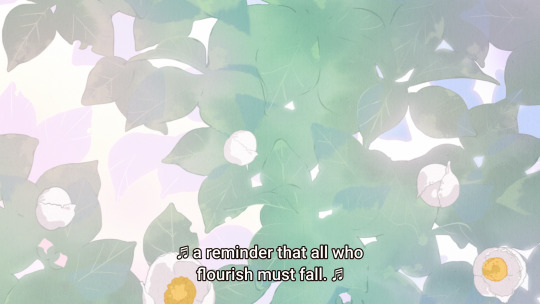
An older Biwa recites the first words of the Heike Monogatari, the story we’re about to watch. The biwa hōshi became much more established after the events portrayed in the story, and the Heike Monogatari was one of their major performances. Biwa is not a historical character, but a standin for the biwa hōshi who created the story.
Next, we’re introduced to the Taira themselves, when Biwa shows up at their court...

A shirabyōshi - a type of courtly entertainer who performs dances in men’s clothing - is performing a dance in front of a lively feast. This may be Giō, but we won’t meet her until the next episode.

The leader of the Taira is Taira no Kiyomori, seen here on the right alongside his wife Tokiko. Although one of the most powerful people in Japan, he is now very bored with life. His visiting brother Tokitada boasts of the power of the Taira, reeling off just how many of them occupy senior positions in government.

Some background: the Taira are the last remaining warrior clan, who gained a great deal of influence by suppressing the Hōgen and then Heiji rebellions. Wikipedia:
Due to his status as the head of the sole remaining warrior clan, Kiyomori was in a unique position to manipulate the court rivalry between the retired emperor, Go-Shirakawa, and his son, Emperor Nijō. Because of this manipulation, Kiyomori was able to climb the ranks of government, though the majority of his promotions as well as the success of his family in gaining ranks and titles at court was due to Shirakawa's patronage. This culminated in 1167, when Kiyomori became the first courtier of a warrior family to be appointed daijō-daijin, chief minister of the government, and the de facto administrator of the imperial government. As was the norm, he soon relinquished the position and leadership of the Taira clan, with the goal of maintaining the social and political prestige of having attained the highest office in the land, but being free of the attendant duties.
To do this, he has become a Buddhist monk and shaved his head. We see him hand leadership of the Taira to his son, Shigemori, who looks like this:
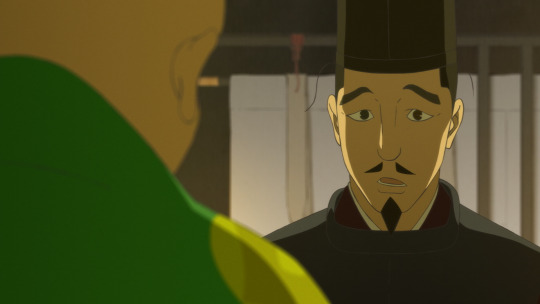
While Kiyomori is something of a chaos agent, known for escapades like bringing a fake sword into the palace to put the shits up everybody, Shigemori is basically an intensely dutiful goody-two-shoes, known as the ‘conscience of the Heike’.
Kiyomori explains to Shigemori that, having relinquished his position, he’s going to go a day’s travel from the capital to Fukuhara and build a seaport and elaborate shrine to further enrich the clan. He frequently admonishes Shigemori for being boring - relating a story of his father Tadamori, the first of the clan to gain rank in the palace, who intimidated the courtiers with a fake sword.
Like Biwa, Shigemori has a special eye, although the colour difference isn’t so pronounced. Where she can see the future, he can see visions of the dead. We learn later that he’s so scared of them that he lines his house with hundreds of lanterns.
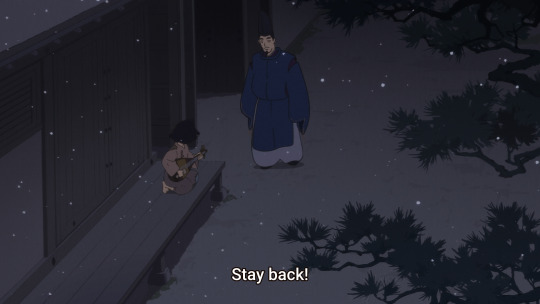
As he ruminates on all this, Shigemori encounters Biwa, who has somehow entered the palace. She warns him that the end of the Taira is near - she’s seen it with her eye - and with his own eye, he can see how her father died. Guilt-stricken over this, he decides to adopt her into his house.
Biwa is dressed up in courtly clothes, but insists on continuing to wear male clothes. Shigemori introduces her to his four children:
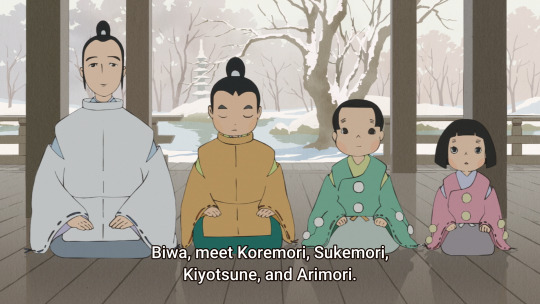
Koremori, the oldest, seems most mature, while Sukemori likes to run about and hunt.
(Confusingly, the English wikipedia says that Koremori was Shigemori’s only child, but this does not seem to be held up at all in the Japanese wiki, which lists all four children.
She’s also introduced to Tokuko, who is Shigemori’s younger sister, and takes an instant liking to her - but is terrified by her vision that Tokuko will die in a whirlpool.

The episode ends with an incident from the Heike Monogatari. During his hunt, Sukemori accidentally insults a visiting dignitary, Lord Motofusa, who is the regent for the child Emperor Takakura (who ascended the throne after the previous sons of Emperor Go-Shirakawa, and his son, both died - more on that in a bit). For this insult, Sukemori was beaten.
Shigemori is like, well that’s a bit much but strictly speaking we broke etiquette here so we shouldn’t do anything about it...

This won’t stand for Kiyomori, who sends out the Heike’s soldiers to attack Motofusa and his ten bodyguards and cut off their topknots. We get an interlude where Biwa explains this in song...
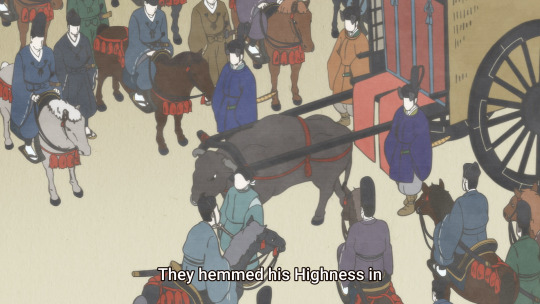
...which she declares as ‘the beginning of the Heike’s villainy’.
Shigemori is appalled.
We cut to another bald man, who in almost every appearance drinks garlic water out of a bowl.
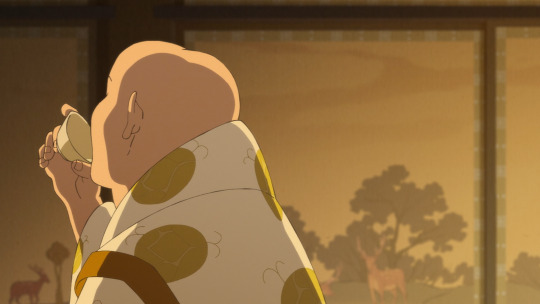
He’s furious that he still has to deal with Kiyomori’s antics after Kiyomori left. Although this isn’t spelled out on screen in this episode as far as I can tell, this is the former Emperor, Go-Shirakawa, who - much like Kiyomori - abdicated to become a monk.
The emperor in this period commonly followed a system called insei or ‘cloistered rule’, in which the emperor formally abdicated and let someone else take over the ceremonial duties, but in fact continued to be the main authority. There is apparently some debate over whether this applies to Go-Shirakawa. In any case, Go-Shirakawa’s sons did not fare particularly well as official emperor. First his first son Morihito became the emperor Nijō until his death in 1165 at age 22; then Nijō’s son Rokūjo ruled until his death in 1176 at age 11 (yeah, he became emperor at age 1); the next up was Norihito who ascended the throne in 1168 at age 7 to become Emperor Takakura. Throughout this period the real power
Then in 1169, Go-Shirakawa actually abdicated for real and became a Buddhist monk. In fact, historically, part of the reason for his abdication was apparently feeling that he could no longer control Kiyomori. A year later came the incident where the regent was attacked, placing this episode as happening around 1170.
Episode 2: "The Glory of the Corrupt World is a Dream in a Dream"
This episode begins with Shigemori trying to make amends for the attack ordered by Kiyomori. He exiles his son Sukemori to Ise, and dismisses all the soldiers who participated in the attack. Kiyomori is like ‘total cuck move bro’, but Shigemori warns him that this has made the Heike enemies.
Biwa was brought along to this, and shouts at Kiyomori for being a rich asshole...
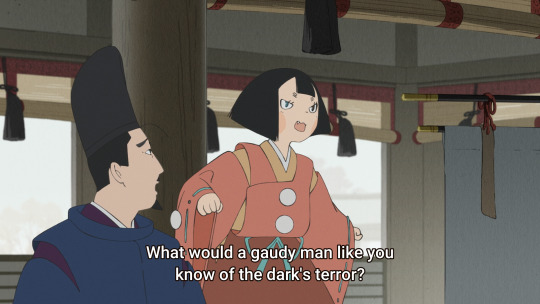
...which leads to him walking up and grabbing her chin to inspect her.

We abruptly cut forward to both Biwa and Kiyomori being dragged away by Shigemori and Tokiko (that is, Kiyomori’s wife, not to be confused with Tokuko, who is Shigemori’s sister!) respectively. We learn that Kiyomori tried to take custody of Biwa, and Shigemori refused.
Tokuko appears on the scene, Biwa explains what happened to Tokuko, who in turn confides in her, talking about her own sister Moriko who got married off at a frighteningly young age...
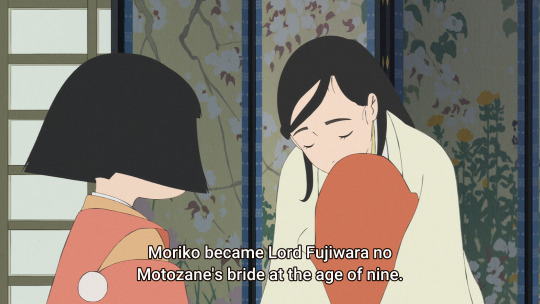
Motozane, from the rival Fujiwara clan, was the older brother to Motofusa, the regent who just got his topknot cut off. However, he died two years after the marriage, and Moriko inherited his lands. She’s not been permitted to marry again in order to keep those lands under the Taira.

In turn, Tokuko is also set to be married off to a ten year old child, Norihito, aka emperor Takakura. This is very confusing, I admit on first viewing I didn’t realise Norihito and Takakura are the same person! Anyway, we cut to Norihito and his father. Here’s Norihito sarcastically mocking his father’s love of imayō songs:

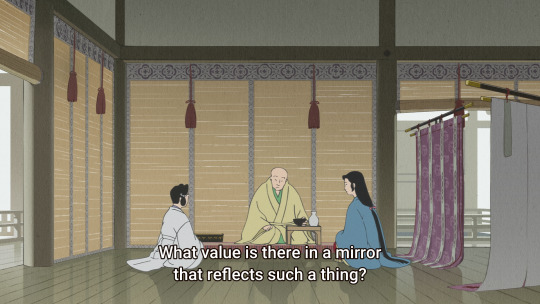
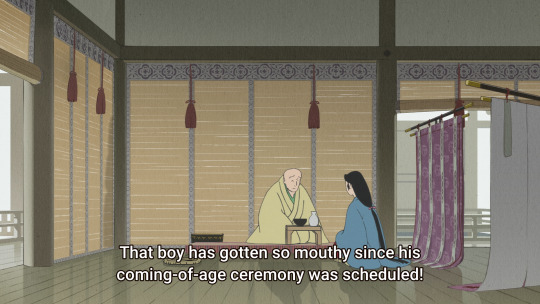
Here, Go-Shirakawa is talking to a woman called Shigeko - presumably Kōtaigō Taira no Shigeko, who is Norihito’s mother - you can read about her here on the translated Japanese wiki corpus. Exactly who was empress when seems to be something of a confusing matter, and seems like it was fine for Go-Shirakawa to sleep with just about whoever he pleased, seriously, check out this list of ‘major consorts’ and the kids he had with them. Also, yeah, as her name suggests, Taira no Shigeko is from the Taira family, and now her son is being married back into the Taira. Aristocrats the world over love their incest!
Meanwhile, back at the Taira estate, a shirabyōshi has just arrived. Biwa at first mistakes her for her mother, who according to Biwa’s father was a shirabyōshi, but realises she’s mistaken.
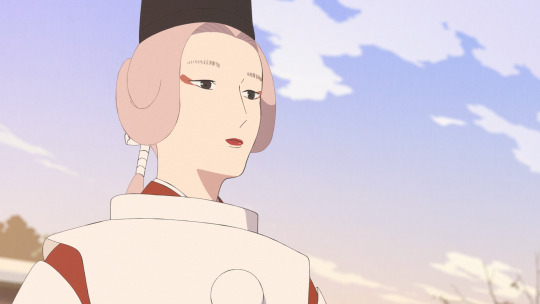
This is Giō, once upon a time the favourite shirabyōshi of Kiyomori, but she lost his favour and was sent away when he became infatuated with a different shirabyōshi, Hotoke-Gozen. Yet, to add insult to injury, Kiyomori started calling her back to provide company to Hotoke-Gozen.
We cut to Shigemori attending an audience with Go-Shirakawa, in which Shigemori announces his resignation. Go-Shirakawa speaks harshly of how un-monastic Kiyomori seems to be acting. Shigemori assures Go-Shirakawa that his ultimate loyalty is to the imperial clan, not Kiyomori.
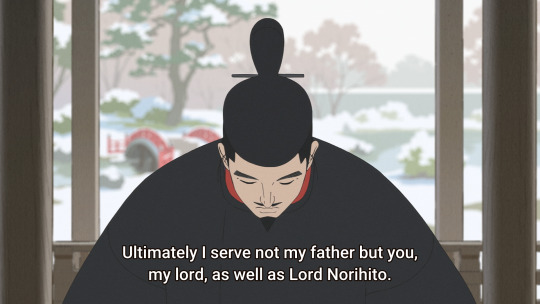
There’s a slightly confusing line here where the subtitle suggests that Go-Shirakawa abdicated and became a monk to hand over the reign to Norihito. I can’t tell if that’s a mistranslation or if they’re just glossing over the history a bit to simplify things?
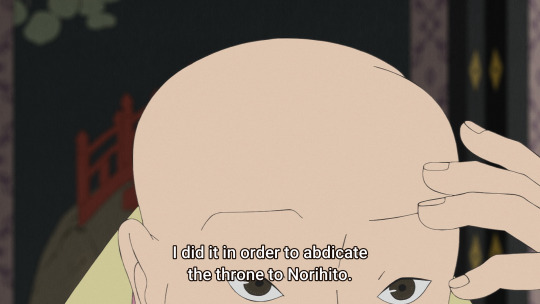
Anyway. We wind the clock forward, and Go-Shirakawa tells some stories about Shigemori over a game with Shigeko. He’s apparently a great warrior, but reluctant to use force. Here’s a Heian-era inspiring speech:
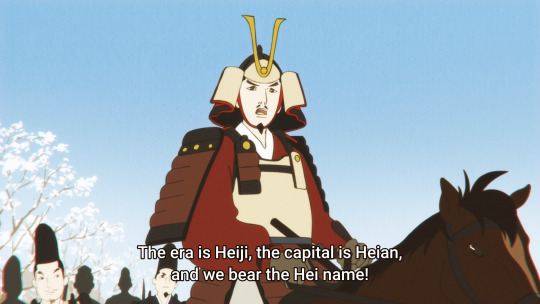
When Go-Shirakawa ordered him to fight monks from the Enryakuji Temple, Shigemori showed up dressed for battle but argued against fighting, so they didn’t - much to the frustration of Go-Shirakawa who wanted to keep the monks in line. Go-Shirakawa hopes that with Tokuko married to the Emperor Norihito/Takakura, the Heike will end up protecting him under Shigemori.
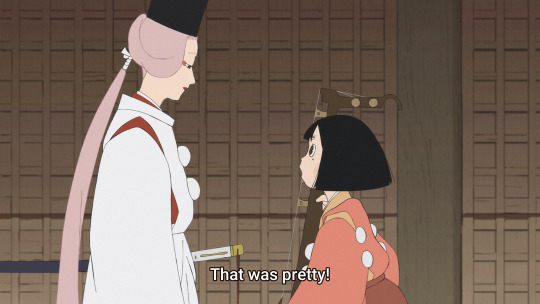
We press on with the story of Giō and Hotoke-Gozen. Giō and Biwa make friends, and Giō dances for her, and for the first time in a while Biwa starts to feel positively about the future. The next time Tokuko returns, Biwa makes an adorable little jump and asks where Giō has gotten to:

However, it turns out that Giō has taken the only avenue available to her to resist Kiyomori, and become a nun along with her sisters. Biwa runs out to find her, and looks into the future with her eye, learning that eventually Hotoke-Gozen will also become a nun and join them...
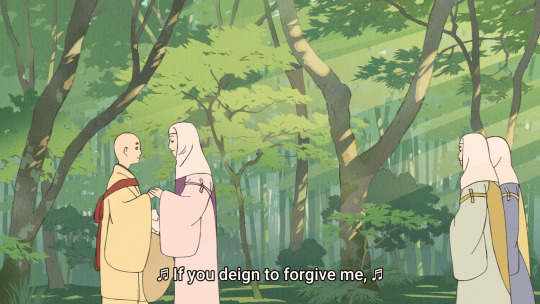
...living their lives together in prayer so they’ll be ‘reborn on the same lotus in paradise’. Mmhm.
Biwa returns to Shigemori, who tells her that Tokuko’s betrothal is official, and she’s travelling away to join her new husband. Biwa begs her not to leave, seeing again the vision of her drowning, but is powerless to stop her.
Episode 3: "Shishigatani Incident"
This episode opens with Shigemori and his family travelling out to the impressive shrine that Kiyomori has constructed out in Fukuhara, in a place called Itsukushima.

There, they watch a dance performance by Koremori, who is Shigemori’s oldest son. Although he’s a good dancer, one of the attendees, Shigemori’s jealous younger half brother Taira no Munemori, sneers at him for being too effeminate:

Kiyomori orders his kids to shut up and pray that Tokuko bears a child. We learn that six years have passed since the last episode, placing it and Norihito/Takakura is now 16. Biwa plays with Shigemori’s sons, now noticeably bigger than her.
On returning, Biwa runs into Tokuko, who is visiting from the imperial court. She expresses her own fears about what might happen to her child.
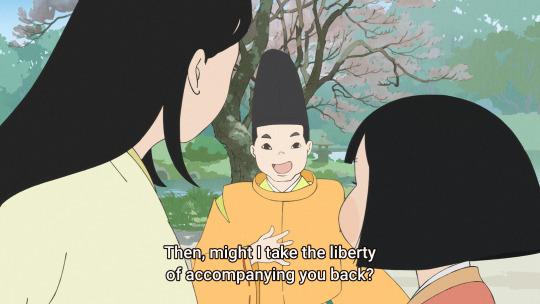
Sukemori is now back from his exile, and has grown a lot bigger. He is attracted to one of Tokuko’s attendants and is a little worked up about it. We learn that Go-Shirakawa is lonely after Shigeko died, and is now coming to visit. His son, the Emperor Takakura, seems to now have a rather strained relationship and goes out to avoid meeting him. In fact, he’s going out to see his mistress Lady Kogo, which seems to be an open secret if not common knowledge. Tokuko is rather blasé about this...

^ That’s not Tokuko pictured, but Iko, the attendant who Sukemori is infatuated with. Sukemori takes the opportunity to entertain Go-Shirakawa with imayō songs.
Where’s Shigemori in all this? He was dealing with some troublesome monks! Fujiwara no Morotsune - that means he’s from the rival Fujiwara clan, like the regent earlier - threw his weight around and burned a temple when they refused him a bath. The Enryakuji monastery demanded punishment. However, their dad, Saikō (another aristo turned buddhist monk, formerly called Fujiwara no Moromitsu), answers to Go-Shirakawa...
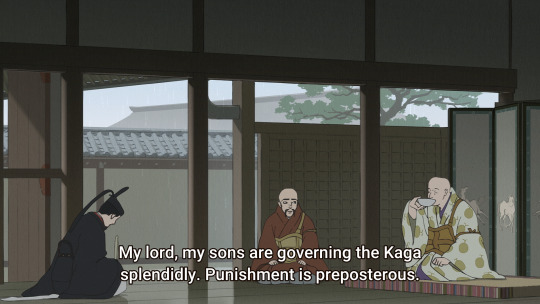
Shigemori argues that the two rogue aristos should be punished. While Go-Shirakawa deliberates, the monks march on the palace, bringing with them portable shrines...

...which settles the matter: Go-Shirakawa orders Shigemori to fight off the monks. Biwa sings to tell us that, despite Shigemori’s orders to shoot only to scare and not shoot the portable shrines, his soldiers cannot control their fire and the monks are massacred.

We move forward a little, and onto the conspiracy which gives the episode its title, the Shishigatani Incident! Oh, there’s a fire at the palace too which destroys Shigemori’s estate, but it passes by in a brief flashback...

A group of officials meet in a secluded location, the monk Shunkan’s villa. Among them Go-Shirakawa, Saikō, and someone called Narichika who’s the brother of Shigemori’s wife, and whose daughter is the wife of Shigemori’s son Koremori. Saikō argues that it is necessary to attack the Heike, since Kiyomori still holds far too much power, and Shigemori was unwilling to be too hard on the monks. Shunkan suggests calling on the Genji, the clan put down in the Heiji rebellion, whose son Yukitsuna still lives.
Unfortunately, Yukitsuna betrays the conspirators and reports this to Kiyomori, who immediately moves to arrest Shunkan, Saikō and Narichika. He further plans to take Go-Shirakawa into custody. Appalled at his father’s actions, Shigemori moves to gather his own allies in case he has to move against Kiyomori. Biwa chases after him, and begs him to come back rather than get himself killed, but Shigemori is determined.
Saikō is executed before Shigemori can intervene. After shaking off Biwa, Shigemori challenges Kiyomori explicitly...

At issue are the two Confucian ideals that rule Shigemori’s life, loyalty to the emperor whose patronage raised up his clan, and filial piety. Shigemori announces that he will, if necessary attack Kiyomori...

The episode ends on this ultimatum...
Episode 4: "Unwritten Affair"
We don’t immediately find out what became of Shigemori’s ultimatum - instead, we see Tokuko giving birth, and suffering badly. But Shigemori’s there so presumably Kiyomori backed down! In his special eye, Shigemori sees the ghosts of those killed by the Taira clan standing around her.
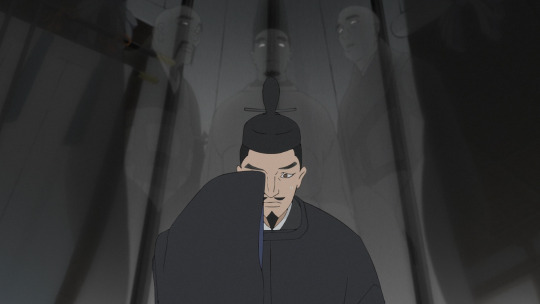
Emperor Takakura thanks Shigemori for his intervention, but reports that his father has now fully retreated from politics, spending his days compiling imayō poems. Shigemori promises that the Taira will remain loyal. He explains to Biwa that his vision showed him not just Saikō but the three other conspirators who were exiled to the unpopulated isle of Bizen.
Believing this to be the source of Tokuko’s sickness, Shigemori goes to see Kiyomori again while he’s in town. Meanwhile Sukemori explains his romantic woes to Biwa giving us this nice little Heian period pogchamp...
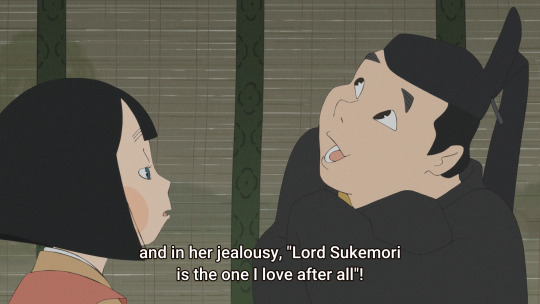
Anyway, Shigemori pleads with Kiyomori to free the exiles, playing on his fervent wish for a great-grandchild in the imperial house. Kiyomori agrees... but only pardons two of the three exiles, leading to this absolutely brutal scene:
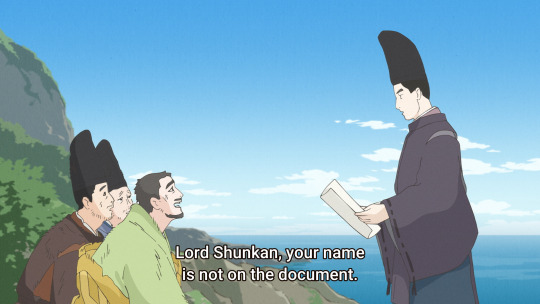
Two of the three exiles are pardoned, leaving Shunkan to desperately chase after the boat.
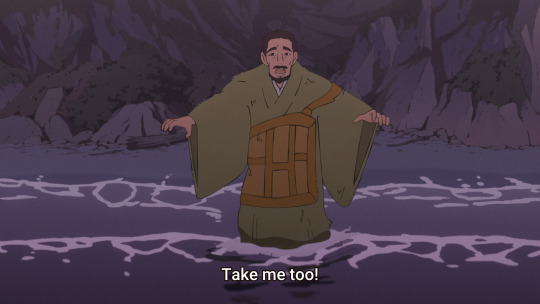
Biwa sings as we watch the other two exiles turn away in shame as Shunkan swims out to sea, and presumably drowns for all we know.

Shigemori can only speculate about why he made this decision.
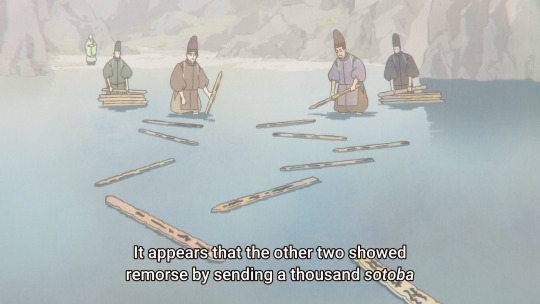
This intervention seems to work, and Tokuko’s condition improves. Alas, we learn the other exile Narichika - the father of Koremori’s wife - starved to death in exile in remote Bizen.
Tokuko gives birth surrounded by rituals like dry-firing bows and scattering rice on the ground. She survives the childbirth, much to Kiyomori’s delight...
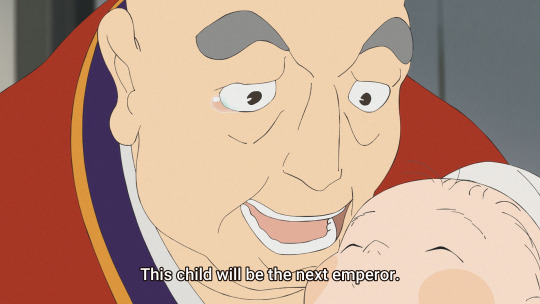
Tokuko, meanwhile, asks Biwa to use her power to peer into the child’s future. Biwa refuses to tell her, but we see that the child is also fated to drown.

Anyway then more natural disasters pass by in a flash! A whirlwind strikes the capital. This doesn’t appear in the show, but according to the Heike Monogatari, offscreen, Shunkan is helped to leave the island but dies by fasting. Wiki summary:
Kiyomori's daughter Tokuko gives birth to the future Emperor Antoku (1178). A loyal youth in service of Shunkan, Ariō, journeys to the island finding Shunkan barely alive. Hearing the news of his family's death, Shunkan kills himself by fasting (1179). His suffering as well as the whirlwind that strikes the capital are seen as signs of the fall of the Taira.

Then, Moriko, Tokuko’s sister, dies at age 24. Resentfully, Tokuko says that her loneliness is because the value of the land she held - if she was married, the Taira would lose hold of them. Apparently her death is seen as further divine punishment.
Shigemori expresses his fears to Biwa: Kiyomori is doing nothing to help the people but only worrying about his designs for his son and the Taira’s power. Moreover, the onmyōji (divination officer) predicts a great catastrophe and war in a hundred days. He goes on a special pilgrimage, taking Biwa with him. She is finding that seeing the future is not much of a blessing...
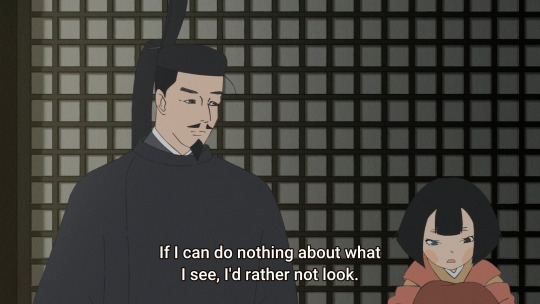
On the pilgrimage, he prays that Kiyomori will seek no further glory, and failing that, that he (Shigemori) will die before witnessing the impending fall of the Taira...

Biwa has a vision of a flame rising out of him into the sky, but when she tries to relate this, she is shushed by Koremori who has accompanied them on the pilgrimage.
Shigemori’s prayer is answered, and he soon falls ill.
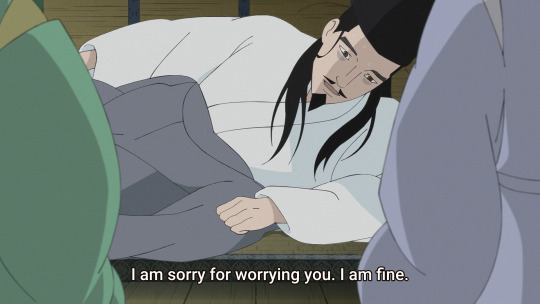
Go-Shirakawa comes to visit, and tells him he must outlive Kiyomori. He discusses Shigemori’s condition with the sons, who quickly change the subject to suggest music, resulting in this absolutely delightful expression:
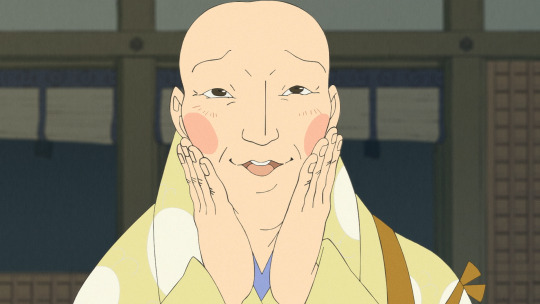
I would love to see the historical Go-Shirakawa react to this depiction lmao. I mean, once he gets over the whole ‘anime exists’ thing.
Shigemori has a fever dream, in which he sees the Buddhist-Shinto metadeity the Kasuga Daimyojin taking Kiyomori’s head. Kiyomori then appears, saying his catchphrase, ‘amusing, is it not?’
Shigemori cries, and drags himself out of bed to present a special funeral sword for Kiyomori’s eventual funeral to Koremori, naming him the successor...
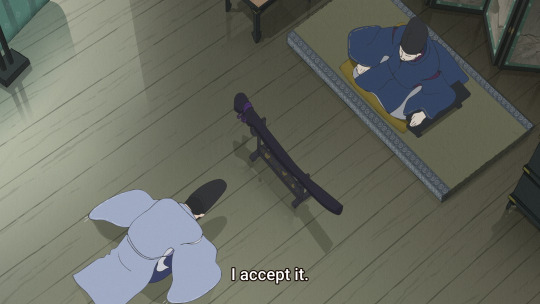
Not long after, Shigemori falls even further ill.

He dies with Biwa at his side, apologising for dragging her into the Heike’s inevitable ruin. She plays her biwa as he slips away. She cries, in grief and her own powerlessness.
But at the end of the episode, she witnesses two blue orbs, which she recognises as Shigemori and her father. She realises she might have inherited his power.
And that’s as far as we got. We can only guess what’s about to happen now that Kiyomori has nobody to challenge him anymore. But I’m hooked. And this summary doesn’t capture anything of the exquisite direction and animation and music throughout.
Anyway, we won’t be able to run it tonight without clashing with mogs, where an animation I made will debut - so instead the followup stream is planned for Sunday evening, see you then!
7 notes
·
View notes